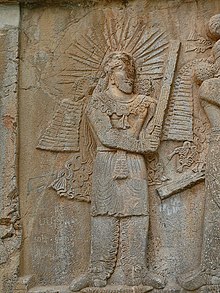

TYPE: God of the upper air
ORIGIN: Persian (Iran)
KNOWN PERIOD OF WORSHIP: circa 400 BCE to CE 200
SYNONYMS: Mitra (Hindu); Mithras (Roman)
CENTER(S) OF CULT: Throughout area of Persian influence.
ART REFERENCES: Various sculptures and reliefs.
LITERARY SOURCES: Avesta
INFORMATION: Originating in India, Mithra is a god of light who was translated into the attendant of the god Ahura Mazda in the light religion of Persia; from this he was adopted as the Roman deity Mithras. He is not generally regarded as a sky god but a personification of the fertilizing power of warm, light air. According to the Avesta, he possesses 10,000 eyes and ears and rides in a chariot drawn by white horses.
In dualistic Zoroastrianism, which effectively demoted him, Mithra is concerned with the endless battle between light and dark forces; he represents truth. He is responsible for the keeping of oaths and contracts. He was born from a rock and, according to legend, engaged in a primeval struggle with Ahura Mazda's first creation, a wild bull, which he subdued and confined to a cave. The bull escaped, but was recaptured by Mithra, who slit its throat. From the blood sprang plant life on earth. His chief adversary is Ahriman, the power of darkness. Mithra is not generally worshiped on his own, but as an integral part of the Mithraic worship of Ahura Mazda, where he acts as an intercessor between gods and men. In the Hellenic period he was transformed more closely to the role of a sun god. See also Ahura Mazda.